by Julie Pigott Dillard | Jan 25, 2019
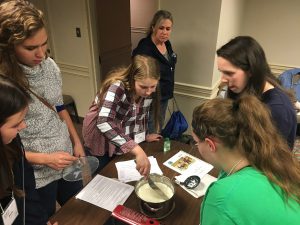
Can making mozzarella cheese really help you find your future career?
As an Extension Agent, I’ve attended numerous 4-H events through the years. Recently, I co-taught workshop at the National Youth Summit on Agri-Science at the National 4-H Center. Along with 4-H Dairy & Poultry Science Specialist, Chris Decubellis, FCS Agent, Jill Breslawski, and Dairy Regional Special Agent, Coleen Larson, we instructed 53 teens from 23 states in our two workshops!
Careers and Cheese…There’s a Connection!
Teens were introduced to agri-science during the keynote address by Mr. Ted McKinney, the Under Secretary of Agriculture for Trade and Foreign Agriculture Affairs. Summit sessions included introductions to career options and agri-science hands-on workshops. The questions and levels of interest were refreshing. I was most impressed with a young lady who expressed hesitation about attending the summit – she thought it would be solely farm-based topics. After she participated in our Exploring Dairy Science workshop (incorporating a presentation on a wide variety of careers available in the Dairy Science field and a hands-on activity making mozzarella cheese), she inquired about my career. As we discussed the vast realm of degrees one could hold to work as an Extension Agent and the wide variety of jobs available in Extension, she then shared she had found some direction for her future study in college when she entered as a college freshman in the fall of 2020.
Look Past the Title
Witnessing teens discover fields of study that meet their interests is the best reward! These type of 4-H youth opportunities help teens in so many ways. I encourage all 4-Hers to look past an event title, explore the event opportunities and keep an open mind. It could be a life changing experience!
For more information on 4-H in your county as well as state and national level events, contact your local UF/IFAS Extension office. Learn more about the Florida 4-H Dairy project.
This article was written by Marie Arick, UF/IFAS Extension Liberty County, County Extension Director & Family/Consumer Sciences Agent.
by Whitney Cherry | Jan 4, 2019
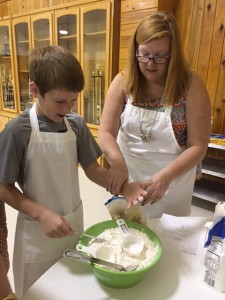
Cooking together makes memories that last longer than gifts. Photo: Monica Brinkley
This is one New Year’s resolution that I can get behind –
give less stuff and give more self. We’ve just wrapped up December – a month of massive giving. We gave gifts, we made charitable monetary donations, and we’ve overdone “bake-and-take” as I call it. It takes a lot of expendable income to give so many things, but you can choose to manage your resources wisely throughout the year and give through acts of service instead.
I particularly love this idea with small children who may want to buy gifts for loved ones but who aren’t old enough to earn money yet, but it works great for kids of all ages. Rather than doing coupon books for hugs and kisses (cute and welcome as those may be), I help them arrange to spend part of a day with a loved one instead. They help with household chores, do some baking or cooking with them, tackle a difficult chore and so on. Not only are they helping with age appropriate tasks, but they’re getting to spend time together and make memories.
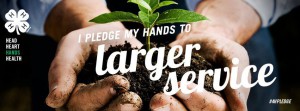
Encourage youth in your life to look around during the year and see who needs help and what they can do to help. Instead of giving more stuff, give more self.
4-H teaches youth life skills such as planning/organizing, wise use of resources, social skills, and character. By encouraging 4-H youth to serve in any large or small way they can, we help them build these and other crucial life skills. Find your local UF/IFAS Extension office to explore how 4-H teaches youth valuable life skills through its project areas..
by Rachel Pienta | Dec 12, 2018
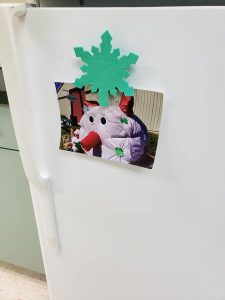
Here’s an example of a decorated clothespin magnet holding a photo.
Slow Down to Savor the Season
The weeks leading up to the gift-giving holiday season can be hectic and stressful. Full social schedules and crowded stores can make Christmas seem like an expensive chore. One way to restore some of the joy of the season and regain some valuable family time is to make thoughtful giftsathome.
Craft a Gift That Everyone Can Use
Every year, the postal service brings glossy family photo cards to my home from friends near and far. Our family likes to make them part of the festive décor for the holiday season by displaying them with homemade r refrigerator magnets. This magnet craft is one you can make with your entire family or at a 4-H Club meeting and give them as gifts.
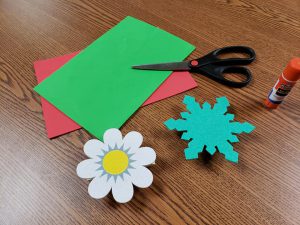
Foam board cut outs can be glued to the clothespin to make fun magnets to give as gifts.
Basic Items to Get Started
Square wooden clothespins
Glue
Scissors
Adhesive magnet strips
Craft foam sheets
Markers
Glitter
Ribbon
We have decorative magnets and like to rotate them with the season. Decorative details are limited only by your imagination and the weight that the magnets will support. Trial and error with magnet strength is recommended and is a great way to spark a STEM discussion while creating art together!
Follow these simple instructions:
- Measure the magnet strip to cover the “back” of the clothespin.
- Cut to length. (Adults may need to help younger kids with this.)
- Attach the magnet strip to the “back” of the clothespin.
- Add decorations or art work like foam cutouts to the “front” of the clothespin.
Gift Ideas
- Packaging the magnetic clothespins with a family photo or a child’s artwork.
- Using a decorated clothespin magnet to hold a gift tag and include with a larger wrapped gift.
- Giving cookies or other baked treats? Clothespin magnets make great recipe holders!
4-H is a great place for your child to express their creativity. For information about 4-H in your county, please click here.
Additional Ideas & Resources for Clothespin Magnets
DIY Clothespin Magnets!
https://www.diynetwork.com/how-to/make-and-decorate/crafts/how-to-make-refrigerator-magnets-from-clothespins
Teachers Gifts: DIY Magnetic Clothespins
by bestevez | Nov 30, 2018

Every organization has its own culture, and 4-H is no exception. Here are the ones that make 4-H unique!
What is 4-H?
4-H is the youth development outreach program of Land Grant Universities, the Cooperative Extension system, county government, and the United States Department of Agriculture.
4-H members are actively involved in educational projects that are fun but also instill life skills while working with caring adult leaders. 4-H projects use quality curriculum incorporating the most current research and knowledge available through the Land Grant University system.
4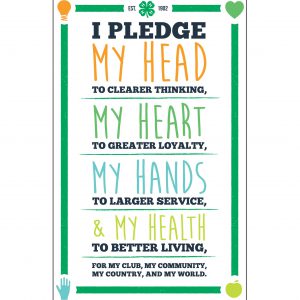 -H Pledge
-H Pledge
The 4-H Pledge states what we want youth to achieve as a result of their involvement in the 4-H Youth Development program. It reminds members of the four areas of growth 4-H targets and reinforces the importance of mastery of life skills.
4-H Colors
The 4-H colors are green and white. White symbolizes purity and high ideals. Green, nature’s most prominent color, represents growth.
Motto: “To Make The Best Better”
The motto’s intent is to inspire young people to continue to learn and grow and to make their best efforts better through participating in educational experiences.
Slogan: “Learning By Doing”
This sums up the educational philosophy of the 4-H program. Young people learn best when they are involved in learning. The intent is for youth to become engaged in learning by doing, reflecting on their experiences, and applying it to future situations.
4-H Name and Emblem
The 4-H Youth Development Program is represented by a popular, recognizable image that consists of a green four-leaf clover with a right turned stem and the letter “H” in white on each leaflet.
The text, 18 U.S.C. 707, appears with the emblem.The name and emblem are held in trust by the Secretary of the USDA and are protected by Title 18 of the United States Code, Section 707 (18 U.S.C. 707). This means it is afforded the same status and regard as the White House and Presidential Seals and may only be used as authorized by the statute, regulations and guidelines, and according to the authorization of the Secretary or designated representative.
I hope you enjoyed learning more about the culture of 4-H. Use of the 4-H name, motto, slogan and emblem signifies youth, adult leaders and 4-H Agents agree to the principles of youth development promoted through 4-H. To find about more about 4-H in your county, click here.
Want to learn more?
by Rachel Pienta | Sep 21, 2018
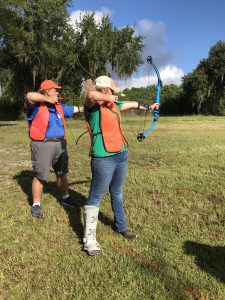
4-H Volunteers learn and practice the archery pre-shot routine so they can teach it to their youth. Photo: Julie P. Dillard
Ready to Lead
Sixteen 4-H volunteers joined ranks with one of Florida 4-H’s largest projects by earning their Level One Shooting Sports Instructor certification September 8. Training participants included 4-H volunteers and UF/IFAS Extension staff from Escambia, Holmes, Jefferson, Marion, Wakulla, Walton, Union and Alachua counties. What sets 4-H instructor training apart from other shooting sports trainings is the focus on youth life skills and positive youth development as opposed to focusing only on skill mastery.
About Florida 4-H Shooting Sports
The 4-H Shooting Sports Program teaches young people safe and responsible use of firearms, principles of archery and hunting basics. Lifelong skill development is one of the main benefits of involvement in the 4-H Shooting Sports Program and applies to both youth and adults involved in the program. Specifically, the 4-H Shooting Sports Program is designed to:
- Provide youth proper training in the use of firearms, archery equipment, and other areas of shooting sports.
- Provide thorough instruction in shooting sports safety.
- Develop life skills such as self-confidence, personal discipline, responsibility, and sportsmanship
- Create an appreciation and understanding of natural resources and their wise use.
- Provide volunteer instructors safe and proper instructional techniques.
- Show volunteer leaders how to plan and manage 4-H Shooting Sports Clubs. (Culen et al, 2018).
Resources for Success
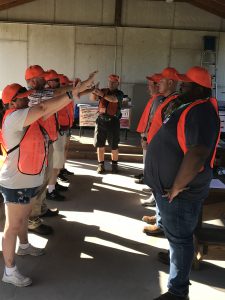
Establishing eye dominance is one of the first tasks of new member. Photo: Julie P. Dillard
It’s important to equip agents, volunteers and youth with the tools they need to succeed in the Florida 4-H Shooting . To assist you in organizing the county shooting sports program, here are some resources from the 4-H State Shooting Sports Committee and Environmental Sciences Action Team:
State Match Information, Rules and Risk Management
Youth Project Books
Getting Organized
To learn more about your county shooting sports program, contact your local 4-H agent.
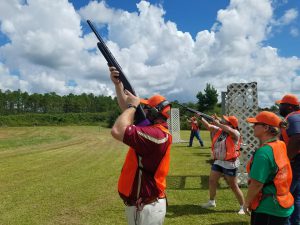
Wakulla 4-H Shooting Sports Club Leader, David Pienta, takes aim during shotgun instruction. Volunteers practice peer teaching to get ready to teach 4-H youth.
by Yolanda Goode | Sep 14, 2018
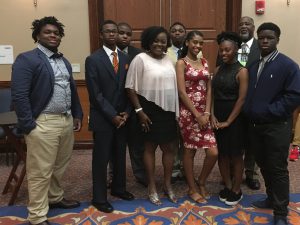
Gadsden County 4-H youth on campus for 4-H University. 4-HU is the premier youth leadership development event of Florida 4-H.
Leaders – Born or Made?
Many of us have heard the saying, “oh, that young man or woman is such a natural born leader.” But are leaders born that way, or do they develop into leaders? These Gadsden County delegates took advantage of 4-H University this summer – an awesome Florida 4-H state event designed to grow leadership skills. Many of them have also served as volunteer 4-H camp counselors during the summer. They understand that leaders are developed and not born.
What Defines a Leader?
Sometimes people confuse charisma with leadership abilities. Charisma is a special magnetic charm or appeal (Merriam-Webster Dictionary). Many of our local to national leaders have some level of charisma. In addition to charisma, leaders should have the more important skills such as communication, problem solving, critical thinking, managing, and self-awareness. There are many definitions for leadership because there is no universal definition. Leadership involves a process while a leader is the one who carries out the process.
How Does 4-H Unlock Your Leadership Potential?
One of my favorite teaching tools used to develop my Gadsden County 4-H leaders is the “Unlock Your Leadership Potential” by UF/IFAS Extension. It has influenced how I would define a leader. The overall goal of a good leader is to move the group or organization toward its goals while building a sense of togetherness and well-being.
Florida 4-H grows leaders at the club, county, district, and state levels by creating safe and nurturing environments and providing quality experiences. Knowledge and skills are great, but being able to apply them through experience is what fortifies and matures youth as well as increases their confidence. The 4-H slogan, “Learn by Doing”, is why the 4-H Experiential model is important to UF/IFAS-Extension 4-H Youth Development Program. The more active the youth and the duration of a their engagements in 4-H positive youth development the greater the benefits not just for them but also their communities (2013, National 4-H Council). It takes a whole team of Extension professionals, staff, 4-H Seniors, and volunteers to make the “magic” happen.
Call to Action:
- Begin the journey as a youth or volunteer: http://florida4h.org/getinvolved/
- Engage in local and state 4-H programs: http://florida4h.org/programsandevents_/
- Give to Florida 4-H: https://www.uff.ufl.edu/give-now/?fund_id=003603
- Read and share the other great blogs by my colleagues here: https://nwdistrict.ifas.ufl.edu/4hn/
- Join the “30 Days of Doing” 4-H Movement: https://4-h.org/inspire-kids-to-do/
References and Further Reading:











